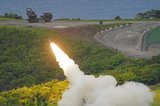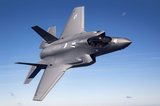Pentagon report claims Chinese bombers training for US strikes
Chinese bombers are likely training for strikes against US and allied targets in the Pacific, according to a new Pentagon report that also details how Beijing is transforming its ground forces to ‘fight and win.’
The annual report to Congress, released on 16 August, highlights China's growing military, economic and diplomatic clout and how Beijing is leveraging this to rapidly build its international footprint and establish regional dominance.
In the case of China's air power, the report states that Chinese bombers are developing capabilities to hit targets as far from China as possible.
Noting how China is pushing its operations out into the Pacific, the document states: ‘Over the last three years, thePLA (People's Liberation Army) has rapidly expanded its overwater bomber operating areas, gaining experience in critical maritime regions and likely training for strikes against US and allied targets.’
In August 2017, six Chinese H-6K bombers flew through the Miyako Strait in the southwest of the Japanese islands, and then for the first time turned north to fly east of Okinawa, where 47,000 US troops are based.
The PLA may demonstrate the ‘capability to strike US and allied forces and military bases in the western Pacific Ocean, including Guam.’
China is engaged in a decades-long build-up and modernisation of its once-backward armed forces, and military leaders have set a goal of fielding a world-class military by 2050.
President Xi Jinping in 2017 ordered the PLA to step up efforts, saying China needed a military ready to ‘fight and win’ wars.
The call has alarmed China's neighbours, several of whom are embroiled in tense border disputes with the superpower.
According to the Pentagon, the PLA in April 2017 undertook a massive transformation of operational and tactical units as part of its structural reforms.
With nearly a million troops, the PLA is the largest standing ground force in the world.
The report notes: ‘The purpose of these reforms is to create a more mobile, modular, lethal ground force capable of being the core of joint operations and able to meet Xi Jinping's directive to 'fight and win wars'.’
China's military budget for 2017 was about $190 billion, according to the report, far behind the Pentagon's annual budget of about $700 billion.
When the Pentagon released its annual report in 2017, Beijing dismissed it as ‘irresponsible’ in predicting that China would expand its global military presence by building overseas bases in countries like Pakistan.
The 2018 report reiterates that China will seek to establish new bases in countries such as Pakistan.
Key to this expanding footprint is China's ‘belt and road’ initiative that seeks to bolster ties with other nations through lending and infrastructure deals.
The document also shines a light on China's ongoing military preparations for a ‘contingency’ in the Taiwan Strait.
Officially, China advocates for a peaceful reunification with Taiwan, but it has never repudiated the use of military force, the document notes.
It states: ‘The PLA also is likely preparing for a contingency to unify Taiwan with China by force, while simultaneously deterring, delaying, or denying any third-party intervention on Taiwan's behalf. Should the United States intervene, China would try to delay effective intervention and seek victory in a high-intensity, limited war of short duration.’
To the ire of regional neighbours, China has built a series of islets and ocean features into military facilities in the South China Sea.
Beijing has now stopped substantial land reclamation.
The report says: ‘However, it continued to build infrastructure at three outposts.’
More from Defence Notes
-
![How might European countries look to tackle drone incursions?]()
How might European countries look to tackle drone incursions?
Disruption of infrastructure in Europe, whether by cyberattack, physical damage to pipelines or uncrewed aerial vehicles flying over major airports, as has happened more recently, is on the rise. What is the most effective way of countering the aerial aspect of this not-so-open warfare?
-
![Taiwan approved for $11 billion weapon purchase from US]()
Taiwan approved for $11 billion weapon purchase from US
The US State Department’s approval of a multi-billion-dollar sale of weapons to Taiwan includes tactical mission networks equipment, uncrewed aerial systems, artillery rocket systems and self-propelled howitzers as well as anti-tank guided missiles.
-
![Ireland spells out $2.3 billion shopping list in five-year defence spending plan]()
Ireland spells out $2.3 billion shopping list in five-year defence spending plan
Ireland’s multi-annual investment in capital defence spending is set to rise from €300m in 2026 to €360m in 2029–2030 with major upgrades across land, air, maritime and cyber domains.
-
![Canada to deepen integration of multi-domain capabilities to strengthen its defences]()
Canada to deepen integration of multi-domain capabilities to strengthen its defences
The Canadian Department of National Defence has created new organisations to manage the procurement and integration of all-domain solutions and allocated US$258.33 million to strengthen production capacities.
-
![US National Security Strategy prioritises advanced military capabilities and national industry]()
US National Security Strategy prioritises advanced military capabilities and national industry
The 2025 NSS has emphasised investment in the US nuclear and air defence inventory and national industry, but it leaves multiple unanswered questions on how the White House will implement this approach.
-
![Canada set to look away from its neighbour and across the Atlantic for partners]()
Canada set to look away from its neighbour and across the Atlantic for partners
While non-EU UK struggles to join the Security Action for Europe initiative, which provides loans for defence programmes, Canada has become the first country outside Europe to get access – and did so for a nominal fee.
























